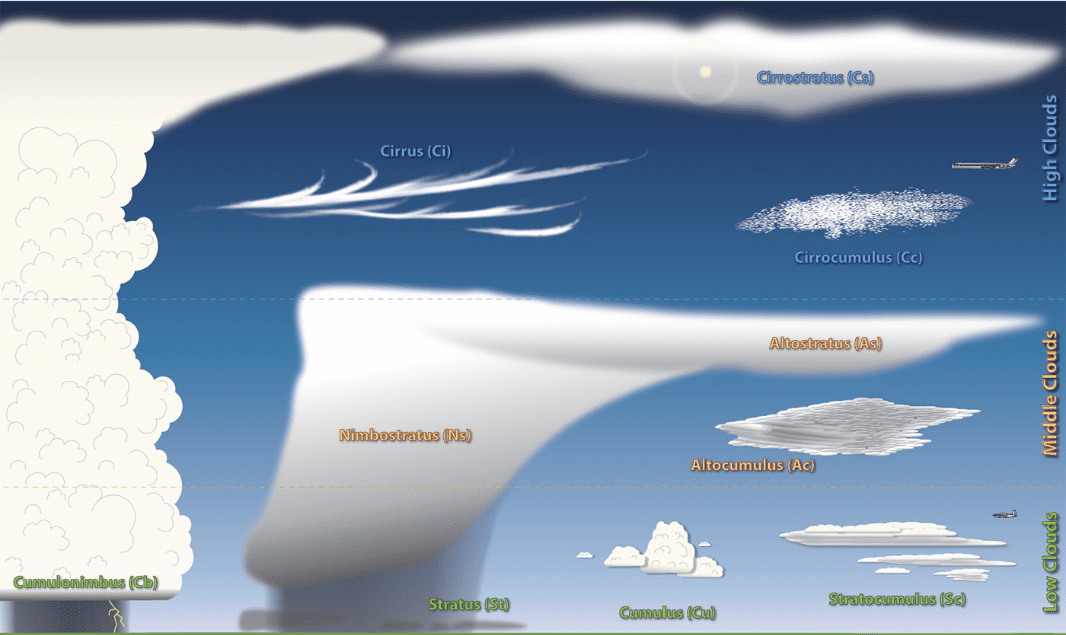Despite common ideas, you cannot actually walk on clouds. If you tried to do so, you would plummet straight through and just get a little wet in the process – that is, unless you’re unlucky enough to fall through a cumulonimbus cloud.
Cumulonimbus clouds are the villains of the cloud world. Characterized by towering columns of turbulent layers of cloud, these menacing formations of water vapor are the only ones known to produce thunder, lightning, and hail, and they certainly look the part. While most clouds don’t even reach 2,000 meters (6,500 feet), cumulonimbus clouds climb up to 20,000 meters (60,000 feet) to create a huge anvil shape.

The cumulonimbus cloud towers over all others.
Image credit: National Weather Service/NOAA
Lieutenant Colonel William Rankin is one of only two people who have ever fallen through a thunderstorm cloud and lived to tell the tale, and his story is a remarkable but terrifying example of what happens if you get stuck inside a cloud.
On July 26, 1959, Lieutenant Colonel William Rankin and his wingman Herbert Nolan were flying their F-8 Crusader jets towards South Carolina. They were aware of some imposing storm clouds ahead and so took the precaution to climb above them to around 14,300 meters (47,000 feet), giving themselves a little leeway above the clouds’ peak.
While above the storm, though, Rankin’s engine suddenly experienced an unexplained fault and stopped. Equipped with no pressure suit, Rankin wasn’t too keen on ejecting into -50°C (-58°F) temperatures and air with so little oxygen he couldn’t breathe, but at 6:00 pm, he realized he had no other choice. He pulled the ejection handle at 14,300 meters (losing his glove in the process) and braced against the horrific outside conditions.
Immediately, blood began to pour from his eyes and ears as the instant decompression from his sheltered capsule gave way to the outside pressure and his abdomen began to swell. He had lost his glove during the ejection and his hand began succumbing to frostbite in the freezing temperatures, only adding to his list of life-threatening problems.
Rankin was now entering a cumulonimbus cloud with just emergency oxygen and a parachute that was not exactly designed for the middle of a thunderstorm. He hadn’t pulled the parachute cord just yet, as Rankin had the presence of mind to know that would be a death sentence. He deployed a barometer that would automatically release the parachute when his altitude reached around 3,048 meters (10,000 feet) and hoped he would come out of the thunderstorm before he suffocated or froze to death.
For what felt like an age, Rankin stayed within the cloud, being thrown about by the raging updrafts that form such extreme weather. Scientists know very little about the inner workings of these violent storm clouds, but the rising hot air is more than powerful enough to have tossed him around while hailstones and lightning threatened to end it all.
Soon, his parachute deployed, leading Rankin to believe he was at 3,048 meters, but he was nowhere near. The pressures within had triggered his barometer and now Rankin was being lifted directly upwards as the updraft caught his parachute. Repeatedly, the updrafts lifted and dropped him, over and over while he dodged shards of ice and held his breath when the air became so saturated with water he could have drowned.
Mercifully, the storm eventually released him and he drifted downwards until he collided with a tree, hitting his head on the trunk as he fell from the branches. He checked his watch and noticed the time was now 6:40 pm – he had been within the cloud for around 40 minutes. Rankin managed to seek help nearby and went to hospital for frostbite, decompression injuries and other minor injuries, but he had survived relatively unscathed.
Almost 50 years later, Rankin died in 2009 at age 88, having returned to service after the accident and writing the book The Man Who Rode The Thunder. To this day, he is only one of two to have ever survived such an incredible feat, through a mixture of sheer luck and the quick thinking to not pull his parachute as he free-fell into a thunderstorm.
Source Link: The Man Who Got Stuck Inside A Cloud For 40 Horrific Minutes